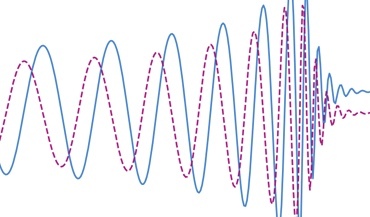 Gravitational memory and spacetime symmetries
Gravitational memory and spacetime symmetries
Symmetries of spacetime infinitely far away from gravitational fields may hint at new laws of nature
Pulsar timing arrays (PTA) are experiments that perform monitoring of pulse arrival times from an ensemble of galactic millisecond pulsars, in order to search for the stochastic gravitational-wave background from supermassive binary black holes. One of the most exciting features of pulsar timing arrays is that most sources of noise are environmental, not just instrumental. This allows studying pulsar magnetospheres, interstellar medium, and more.
This is a short note about noise and signals in PTA.
![\text{PSD}(f_{\text{GW}}):\; \bigg[s^3*\text{strain}^2\bigg]](/assets/components/mathx/76a3b0b95df2e0d3b7f98a28ff2254e4.png)
Data is modeled using a multivariate Gaussian likelihood function, which describes a probability distribution for the data (timing residuals), given the parameters of signals and noise. Each dimension of a multivariate likelihood distribution is related to the observation time.
There are two kinds of signals: deterministic and stochastic. Deterministic signals affect the values of timing residuals as a function of time, while stochastic signals affect the covariance matrix of the multivariate likelihood. Stochastic signals can be uncorrelated in time (white), which are described by the diagonal of a covariance matrix, and time-correlated (red), which generally manifest as a random wandering of pulse arrival times.
| Measured "white" noise parameters of pulsars | Phenomenological "white" noise parameters |
|
|
| The above are factors that should be applied to uncertainty of arrival times (sigma_toa) in order to obtain a total white noise. | The above factors are physical sources of noise in PTA experiments. |
| Uncorrelated between pulsars | Correlated between pulsars |
| Pulsar spin noise - irregularities in pulse ToA due to neutron star physics | Stochastic gravitational-wave background from supermassive binary black holes |
| DM variations - they influence ToA due to interaction of radio-waves with electrons from interstellar medium. Noise PSD depends on radio-frequency. | Solar system ephemeris errors - errors in knowing positions and masses of celestial bodies in the Solar System. This noise can also be modelled as a deterministic process. |
| Jumps, or phase jumps - errors arising from switching observing backends. | Clock errors |
 Gravitational memory and spacetime symmetries
Gravitational memory and spacetime symmetries
Symmetries of spacetime infinitely far away from gravitational fields may hint at new laws of nature
 The nanohertz gravitational wave background
The nanohertz gravitational wave background
Is the common-spectrum process observed with pulsar timing arrays a precursor to the detection?